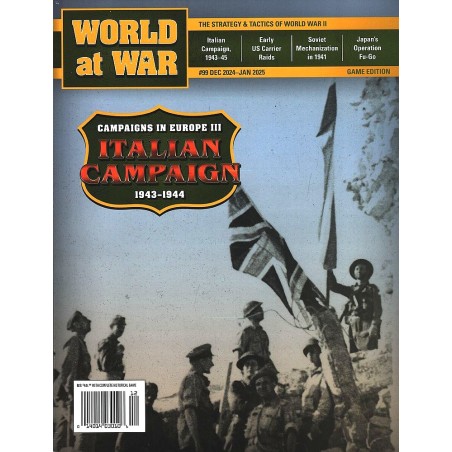- Not available








Italian Campaign, 1943–45
On 4 June 1944, the US Army entered Rome, making it the first Axis capital to fall. What followed was an advance in which the Allies expected to sweep into and beyond northern Italy. However, the Germans fought a skillful delaying action, finally capitulating only on 29 April 1945. Here is our analysis of the Allies’ strategic failure.
 Security guarantees
Security guarantees
100% secure payments: PayPal, Visa, MasterCard, bank cards, alternative payments.
 Delivery policy
Delivery policy
Deliveries by Mondial Relay or Colissimo (French fast postal service).
 Returns policy
Returns policy
Returns accepted up to 14 days after delivery
Articles in the Magazine :
US Carrier Raids Early in 1942 After the attack on Pearl Harbor, the US Navy’s commander in the Pacific, Adm. Chester Nimitz, had one advantage: the Japanese codes had been broken. However, he did not have the eight battleships prewar planners had assumed would be available for the counteroffensive. All he had were a handful of aircraft carriers, cruisers and destroyers. This is how he used them.
Soviet Mechanization in 1941 On the day the Germans invaded the USSR, the Red Army’s mechanized order of battle was immense, with 61 tank and 31 motorized rifle divisions. That amounted to some 9,000 tanks along with roughly 5,000 armored cars. Despite those impressive numbers, the Soviet armored force was plagued with serious weaknesses. Here is our analysis.
Japan’s Operation Fu-Go The US air strike on Tokyo in April 1942 caused little damage but embarrassed the Japanese military high command by demonstrating the Home Islands were vulnerable to attack. Operation Fu-Go (Windship Weapon) was therefore developed by September 1942. It was a way for the Japanese to strike at the US homeland, if only to show their own people America was similarly vulnerable to attack.
The Game:
W99 Italian Campaign 1943-44 (CIE Volume 3)
Campaigns in Europe (CIE) is a two-player series of games focused on campaign scenarios at the division/corps level. The system uses the same maps as War in Europe (WIE), with updated graphics and a more detailed terrain analysis. The counters have been upgraded and are presented with historical identifications. The game system utilizes a Move/Fight, Fight/Move sequence of play to portray simply doctrinal differences among contending armed forces. It also utilizes headquarters units to project logistics and combat support capabilities.
Italian Campaign covers the Italian campaign, from the Allied invasion of Sicily through the Anzio campaign.
Each game turn (GT) represents around one week in clear weather and two weeks in mud and snow game turns. Each hex represents 20 miles (32.5 km) across. German, Finnish, and Western Allied units are shown mostly as division-sized units, with Soviet and Axis Allied units depicted as corps.
22 x 34-inch game map and a sheet of 280 1/2-inch counters.
Design by Joseph Miranda
You might also like